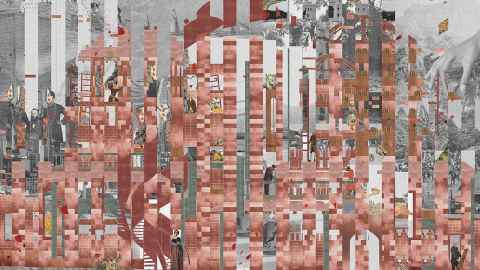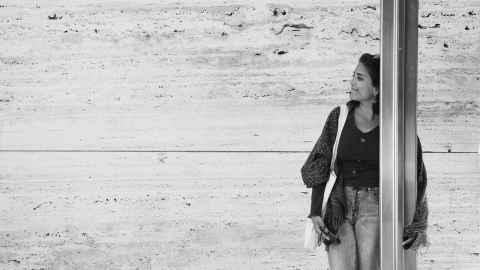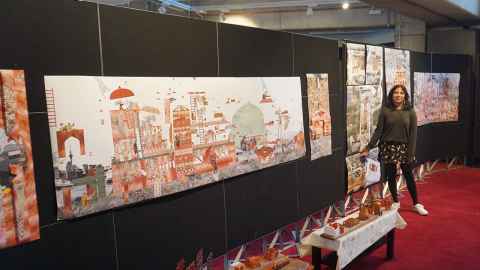Reframing the “monsters” of architecture
15 February 2022
Naomi Vallis, who completed her Master of Architecture (Professional) at the School of Architecture and Planning, has been awarded first place in The Charette’s ‘Architecture Thesis of the Year 2021’ competition.

In her award-winning thesis, "Monsters in Architecture: A quest for the Architectural Representation of South Asian Migration in Aotearoa" she investigates the hidden and often unnoticed cross-cultural architectures that exist in our built environment, Aotearoa New Zealand.
Naomi completed her MArch (Prof) in 2020-2021, and her thesis supervised by Dr Ross Jenner, who introduced her to architectural theorist Marco Frascari’s concept of the “architectural monster”.
These so-called “monsters” of architecture have historically been perceived in a negative light for being hybrid forms, as an unauthentic mash-up of different architectural styles.
But as Naomi argues in her thesis, these “monsters” should be celebrated. They point to the potential of new forms of architecture that allows for and encourages the expression of diversity in the built environment.
Naomi was motivated to write about the “architectural monster” as a means of discovering her own cultural identity as a first-generation migrant from India, having arrived in New Zealand with her family at the age of four.
“I often found myself compelled to explore fragments of my own heritage and culture in the new context growing up,” she says, “and during my Bachelors of Architecture degree, I was drawn to design papers that had an emphasis on people and culture.”

Her thesis began with examining the global migration and transportation of people, culture, indigenous structures, and architectural styles from South Asia to New Zealand. She was particularly interested in on how these architectures have transformed and merged through time with local styles to create an “Architectural Monster”, a building composed of various socio-political and cultural influences.
She points to the 150-year-old Alberton House, in Mt Albert, Auckland, as an example. “The traditional two-storey farmhouse was constructed by architect Matthew Henderson, who drew on owner Alan Kerr Taylor’s English and partial Indian heritage and upbringing in India. This is evident in the presence of the Anglo-Indian arches and verandah that meets with European ogees and half doors typically seen in the indigenous bungalow,” she says.
Another example is the Nehru Hall in Pukekohe, the South Asian communities first community hall in New Zealand. “Within the simple brick design is a similar trend of hybridisation between Mughal and the bungalow style, as seen with the extended Mughal inspired eaves and brick tectonic.”
She explored these ideas in her thesis through the methodology of collage, which included extracting, comparing, and combining various architectural forms from both contexts, to draw attention to the similarities in architectural traditions and cultures, and the relationships between people and architectures often assumed as being separate.
This led to her design of a masonry communal arts centre for her thesis, constructed from stylistic features such as the Mughal and Anglo-Indian arches, polychrome bricks tectonics, an ornamented railing and a stepwell. Each of these features were included with the intention of allowing for particular cultural practices, such as fabric dyeing, fabric printing or garland making.
“This emphasis on acceptance and cultural hybridity is what defines Aotearoa New Zealand, as a country that now prides itself on the diversity and history of people and their cultures,” says Naomi. “It is now time to embrace and celebrate the ‘architectural monster’, as something that provides a pathway to create spaces relevant to all people.”
The jury described Naomi’s thesis as “sophisticated, interesting, and fascinating … profoundly lyrical and poetic without sacrificing anything from the architectural world” which “approached the seemingly mundane phenomenon with great passion and rigour. The research show originality, critical understandings of the tradition of craft and construction, theories, and an interesting personal interpretation.”
The Charette is based in the city designed by the Swiss-French architect Le Corbusier – Chandigarh, India. It was co-founded and launched by graduates of the Chandigarh College of Architecture in 2020 in response to the first Covid-19 lockdown, providing an international platform for young architects and architecture students, and competitions to encourage the pushing of boundaries of what is accepted as the norm in architecture.

Media contact
Margo White I Media adviser
Mob 021 926 408
Email margo.white@auckland.ac.nz